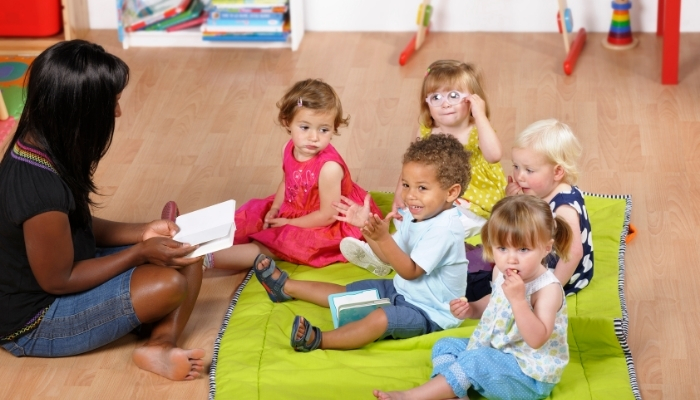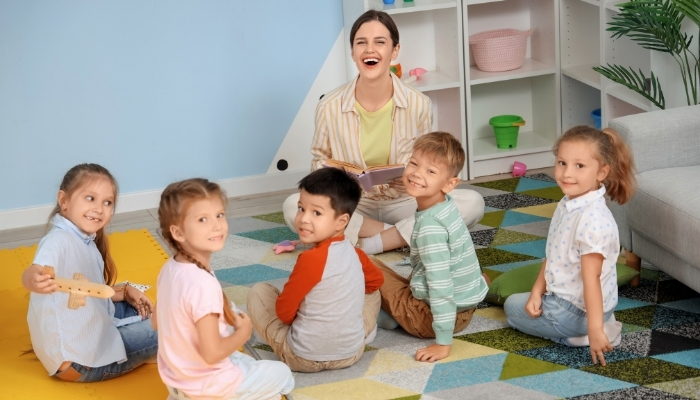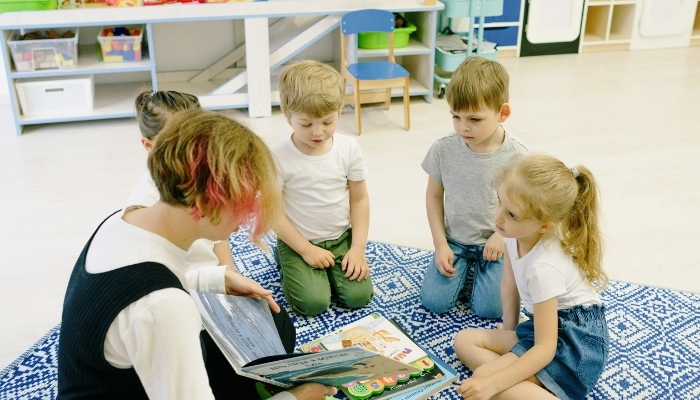Teaching a kindergartener to read is one of the most rewarding parts of early education, but it can also be the trickiest. Some children light up when you ask them to read aloud, while others shrink back, afraid to make a mistake. You can see their potential, but the one-on-one spotlight sometimes makes them nervous, even when they know the words. It’s not that they can’t read; it’s that they don’t feel safe enough to try.
That’s where kindergarten reading groups change everything. When children learn in small, friendly circles with others their age, the pressure fades away. They listen, copy, laugh, and learn together. Watching a peer succeed often gives them the courage to try again, and soon those quiet readers begin to find their rhythm and confidence. The group becomes a space where they feel seen but not singled out, supported, and not tested.
For teachers and homeschooling parents, this approach makes reading time calmer, more engaging, and far more effective. In this guide, you’ll learn how to create small reading groups that bring out the best in every child, through structure, fun, and a learning environment where confidence grows word by word.
Key Takeaways
-
Small reading groups reduce pressure and build confidence by letting children learn alongside peers at the same skill level.
-
Grouping by reading ability, rather than age, ensures targeted instruction in phonics, sight words, fluency, and comprehension.
-
Short, structured sessions with varied activities keep kindergarteners engaged while allowing teachers to closely track progress.
-
Hands-on, interactive games and exercises connect learning to play, helping children apply skills in real reading contexts.
-
Flexible groupings and consistent feedback allow students to progress naturally, making reading both enjoyable and measurable.
What Do You Mean by Kindergarten Reading Groups?

Kindergarten reading groups are small clusters of three to six children who share similar reading levels. A teacher works closely with each group to build specific reading skills, such as phonemic awareness, decoding, and fluency, while other students work on independent literacy activities. This small-group format allows for personalized instruction, immediate feedback, and targeted skill development based on each child’s needs.
Key Benefits of Kindergarten Reading Groups
-
Individual Attention: Each child receives focused support from the teacher. You can closely observe their reading attempts, correct mistakes in real time, and celebrate progress, boosting confidence and motivation.
-
Peer Learning: Children learn from one another by listening, observing, and discussing reading strategies. When one student successfully blends sounds or recognizes a new word, others learn from the example.
-
Targeted Skill Building: Instruction is customized for the group’s current level. Teachers can focus sessions on specific areas, such as short vowel sounds or sight words, without repeating skills already mastered.
-
Active Participation: In smaller groups, every child gets more turns to read aloud, answer questions, and practice literacy skills. This increased engagement accelerates reading growth compared to whole-class lessons.
-
Better Progress Monitoring: Teachers can track performance during each session, identify challenges early, and adjust lessons to meet evolving needs.
Kindergarten reading groups create a safe, supportive environment where young learners feel comfortable making mistakes, trying new strategies, and building a lifelong love for reading.
Also Read: 35+ Read Aloud Books for Kindergarteners
Now that you understand what makes reading groups work, you need to know how to form them correctly.
How to Prepare: Assessing and Forming Groups?

Before forming your reading groups, it’s essential to understand exactly where each child stands in their reading development. Careful assessment shows who needs support with letter sounds, who can blend simple words, and who is ready to read short sentences independently. When you group children based on real data, you create clusters where every student can learn effectively at their own level.
Start with These Quick Assessments
Use short, focused assessments to get a clear snapshot of each child’s current skills:
-
Letter and Sound Knowledge: Show individual letters and ask students to name both the letter and its sound. Note which children know them all and which struggle with specific ones. This simple five-minute check provides crucial insight into each child’s understanding of the alphabet.
-
Phonological Awareness Skills: Ask children to identify the first sound in words like cat or sun, clap out syllables in butterfly or rainbow, and blend sounds you say separately. These tasks reveal how well students can hear and manipulate sounds, key early reading skills.
-
Simple Reading Tasks: Present emergent readers with a short, decodable book. Observe how they approach the text: do they sound out words, rely on pictures, or recognize sight words? Their strategies help pinpoint their reading stage immediately.
Once you’ve gathered this information, group children by skill level rather than age or personality, most kindergarten classrooms end up with three or four flexible groups, depending on class size and the range of abilities.
Common Grouping Categories
-
Emergent Readers: Place students here if they’re still learning letter names and sounds or if they have difficulty blending and identifying initial sounds in words. These children benefit from lessons that focus on phonemic awareness, alphabet practice, and basic decoding activities.
-
Early Developing Readers: Group students who already know most letter–sound correspondences and can blend simple CVC words (like cat and dog). These readers need guided opportunities to apply phonics knowledge to short, connected texts and to expand their sight-word list.
-
Transitional Readers: Assign students here when they can read short sentences with growing fluency and recognize many sight words. Instruction should emphasize reading longer passages, comprehension skills, and fluency building through repeated reading and discussion.
Also Read: 25+ Guided Reading Games for Kids with Practical Tips for Success
Keep Groups Flexible and Fluid
Avoid locking students into fixed groups. Skills develop quickly at this age, and rigid grouping can slow progress for struggling readers. Plan to reassess every four to six weeks, moving children between groups as their abilities grow.
-
Promote a child who has mastered letter sounds to the next level.
-
Provide additional foundational support to one who needs more time.
-
Occasionally, rotate group members within the same skill level to keep sessions fresh and encourage peer learning.
Schedule and Track Consistently
Consistency matters more than length in small-group reading.
-
Meet daily or at least four times per week for steady growth.
-
Keep each session 15–20 minutes long, perfect for kindergarten attention spans.
-
Take quick notes after every session on what each child mastered and where they need more practice.
These notes become your data-driven roadmap for planning future lessons and adjusting group placements. With clear assessments, flexible groups, and consistent instruction, you’ll create a reading routine that truly meets every child where they are and helps them soar.
Kindergarten Small Group Reading Lesson Plans

A strong small-group reading lesson has a clear structure and purpose. Each component, phonics, sight words, reading, and comprehension, works together to help children become confident, independent readers.
Keep lessons short and focused, so kindergarteners stay engaged and energized. Within that time, move through a few brief, high-impact activities rather than spending the entire session on one skill.
Here are the lesson types and how you can implement them in your groups:
1. Phonics and Decoding Practice
Begin each session with explicit phonics instruction that introduces one new sound or pattern each week. Focus on hands-on, multi-sensory learning that makes abstract concepts concrete.
How to teach phonics effectively:
-
Introduce the target sound clearly (e.g., short a in cat, hat, mat).
-
Model how to blend and read simple words containing that sound.
-
Give each child a turn to write and read new words using:
-
Small whiteboards or letter tiles
-
Sand tracing or air writing for tactile reinforcement
-
-
Provide immediate feedback and correction to strengthen accuracy.
-
Keep practicing: have students clap, jump, or tap when they hear the target sound.
Phonics instruction should feel active and joyful, not drill-based. The goal is mastery through movement and repetition.
2. Sight Word Recognition
Sight words form the bridge between phonics and fluent reading. Choose three to five high-frequency words each week that appear often in early texts (e.g., the, and, is, you, see).
Steps to introduce and reinforce sight words:
-
Show each word on a card, say it aloud, and use it in a simple sentence.
-
Have children spell the word aloud while you point to each letter.
-
Mix new and review words to build automaticity.
-
Make learning interactive:
-
Flash cards for quick recognition
-
“Find the word' games in sentences.
-
Small celebrations when a child reads a word instantly.
-
Finish with short sentences that combine sight words and decodable words (e.g., I see the cat, or You can run.). This shows students how sight words fit naturally into reading.
3. Reading Connected Text
Once foundational skills are in place, guide students to apply them in decodable readers that match the phonics patterns and sight words you’ve taught.
How to guide your small-group reading:
-
Begin with a picture walk to discuss what might happen in the story.
-
Read the book together first, pointing to each word in unison.
-
Pause occasionally to discuss key pictures or events.
-
Then, have children read individually while others follow along.
-
Observe carefully: note who sounds out words, self-corrects, or guesses.
-
Give gentle, specific feedback like, “Look at the beginning sound, try that word again.”
This supported reading time helps children connect decoding to meaning, a critical early literacy milestone.
4. Building Comprehension Skills
Even at the kindergarten level, comprehension should be intentional. Help children understand, think about, and enjoy what they read.
Ways to strengthen comprehension:
-
Ask literal questions (“What color was the dog?”) to check basic understanding.
-
Add thinking questions (“Why did the character do that?”) to develop reasoning.
-
Have children retell the story in their own words to assess recall and sequencing.
-
Encourage personal connections (“Have you ever done something like that?”) to make reading meaningful.
Comprehension doesn’t just build knowledge; it helps students see reading as a conversation between text and self.
These lesson components work together to build complete reading skills. Your kindergarteners will progress from learning individual sounds to naturally reading and understanding connected text.
Also Read: Reading Comprehension Games and Activities for Students
The structure matters, but so does keeping children engaged throughout. Let us look at some activities that can make small-group reading something children look forward to.
15 Fun and Engaging Activities for Small Group Reading
To keep kindergarteners engaged, your reading lessons should feel like play, but always with purpose. The following activities combine movement, collaboration, and creativity while systematically strengthening early reading skills.

Here are 15 classroom-tested small-group activities you can implement right away. Each one includes what you need, how to do it, and why it works.
1. Letter Sound Sorting
Set up: Give each child a small tray with picture cards or mini objects (e.g., a ball, a cat, a hat, a sun).
How to do it:
-
Say a target sound, such as /b/.
-
Ask children to look through their objects and find all items starting with that sound.
-
Have them say the sound aloud as they show you each object.
-
Mix in review sounds for practice.
Why it works: Sorting forces children to listen closely to beginning sounds, strengthening their phonemic awareness while keeping their hands busy.
2. Word Family Building
Set up: Provide magnetic letters or letter tiles. Write a word family ending (like –at) on the board.
How to do it:
-
Model how to spell cat, sounding out each letter.
-
Ask children to change just the first letter to make bat, hat, rat.
-
Let each child take a turn being the “word changer.”
Why it works: Children see and hear how one sound change creates a new word, making phonics patterns visual and interactive.
3. Sound Blending Game
Set up: No materials needed, just use your voice and imagination!
How to do it:
-
Say each sound in a word slowly: /c/ /a/ /t/.
-
Have children blend the sounds and say the full word.
-
Make it active, children can jump, clap, or tap their desk for each sound.
Teaching tip: Start with three-sound words (CVC) before introducing blends or digraphs. The movement keeps energy high and improves sound recall.
4. Picture Sound Match
Setup: Lay out 10–12 picture cards. Choose whether you’ll focus on beginning, middle, or ending sounds.
How to do it:
-
Say a sound aloud (for example, /s/).
-
Have children race to find a picture containing that sound (sun, snake).
-
Discuss together which part of the word makes the sound.
Why it works: Encourages listening discrimination and helps children connect print concepts to oral language.
5. Decodable Reader Hunt
Set up: Hide decodable books around your reading area. Prepare a few simple clues using words students can read (“Find the book near the mat”).
How to do it:
-
Read the clue together.
-
Let children search for the hidden book.
-
Once they find it, have them read the book aloud to “claim” their prize.
Why it works: Turns reading practice into an adventure, keeping even hesitant readers motivated and attentive.
6. Roll and Read
Set up: Create a game board with sight words or phonics words on each space. Provide dice and game pieces.
How to do it:
-
Students roll, move, and read the word they land on.
-
If they read it correctly, they stay; if not, move back one space.
-
Mix review and new words to balance challenge and success.
Why it works: Repetition feels like fun instead of drill, giving students multiple chances to practice the same words naturally.
7. Word Building Race
Set up: Give each child a small set of letter cards or tiles.
How to do it:
-
Call out a word (like dog).
-
Children race to arrange their letters to spell it correctly.
-
Have them read it aloud before showing you.
Teaching tip: Start with short words and gradually add blends or digraphs. Praise both speed and accuracy.
8. Sentence Building
Set up: Prepare word cards that can form simple sentences (e.g., I / see / the / dog).
How to do it:
-
Mix up the cards and place them face up.
-
Ask children to arrange them into a sentence that makes sense.
-
Read the sentence together, then have students illustrate it.
Why it works: Reinforces word order, grammar, and meaning while encouraging collaboration and discussion.
9. Sound Box Segmenting
Set up: Draw three boxes on a whiteboard (one for each sound). Give students small counters or chips.
How to do it:
-
Say a CVC word like sun.
-
Children push one counter per sound into each box (/s/, /u/, /n/).
-
Blend the sounds back together and say the full word.
Why it works: Makes phoneme segmentation visible and concrete, a crucial skill for decoding and spelling.
10. Rhyme Time Memory
Set up: Make pairs of rhyming picture cards (cat/hat, log/frog). Lay them face down.
How to do it:
-
Children take turns flipping two cards.
-
If the pictures rhyme, they keep the pair.
-
If not, turn them back over and continue.
Why it works: Builds phonological awareness and memory skills while adding friendly competition.
11. Beginning Sound Bingo
Set up: Create bingo cards with pictures. Call out letters or sounds.
How to do it:
-
Say a sound aloud (for example, /m/).
-
Children find and cover pictures that start with that sound.
-
Continue until someone calls “Bingo!”
Teaching tip: Ask students to name each picture aloud to reinforce vocabulary and sound-letter connections.
12. Sight Word Fishing
Set up: Write sight words on paper fish and attach paper clips. Use a magnet tied to a string as a “fishing pole.”
How to do it:
-
Children “catch” a fish and read the word aloud.
-
If correct, keep it; if not, return it to the pond.
-
End with a short story using the words they caught.
Why it works: Makes repetitive sight word practice exciting and kinesthetic.
13. Story Sequence Cards
Set up: After reading a simple story, hand out picture cards showing major events.
How to do it:
-
Ask children to arrange the cards in the correct order.
-
Discuss why each event happens next.
-
Have them retell the story using the cards as prompts.
Why it works: Strengthens comprehension, sequencing, and retelling, key indicators of early literacy growth.
14. Fluency Repeated Reading
Set up: Choose a very short text (3–5 sentences) that includes familiar phonics patterns and sight words.
How to do it:
-
Read together once for accuracy.
-
Read again, focusing on smoothness.
-
Read a third time with expression.
Teaching tip: Track progress on a simple fluency chart so children can see improvement over time.
15. Word Hunt in Books
Set up: Give each group of children a decodable reader.
How to do it:
-
Call out a sight word or phonics pattern.
-
Have children search their books to find examples.
-
When they spot it, have them read the word aloud in context.
Why it works: Encourages children to look closely at print and apply what they’ve learned during real reading.
These activities transform small group reading time into something children look forward to. The hands-on nature and game elements maintain engagement while systematically building crucial reading skills.
Also Read: Top 15 Books for Shared Reading in Kindergarten
Now you know what to teach and how to make it engaging. But running these groups smoothly takes some practical know-how.
Tips for Conducting a Successful Small Group Reading Lesson for Kindergarteners
Running small group reading lessons doesn’t need to feel hectic. With a few innovative systems in place, you can keep lessons efficient, focused, and enjoyable for both you and your students.

-
Begin with a Quick Warm-Up
Start each session with a two-minute review. Flash a few sight words or letter cards, or ask children to read one short word from the previous lesson. Keep it quick and lighthearted so students settle in and know it’s time to read.
Tip: Store your warm-up materials in a small folder or a zip bag so you can grab them instantly.
-
Keep Lessons Short and Focused
Aim for 15–20 minutes per group. Divide that time into short activities: a review, a focused skill task, and a fun closing activity. A predictable structure helps children stay calm and focused, especially at the start of the year.
Sample flow:
-
3 minutes – warm-up
-
8 minutes – new skill or guided reading
-
4 minutes – quick review or reading game
-
Prepare Materials Before You Start
Have everything within arm’s reach before calling your group. Use color-coded bins or trays for each group’s books, cards, and writing tools. This prevents distractions and keeps transitions smooth.
Tip: Label bins with both words and pictures so students can help with setup and cleanup.
-
Use Visual Timers to Stay on Track
A simple visual timer keeps everyone focused. Children can see how much time is left, which reduces “Are we done yet?” questions. It also helps you keep sessions consistent from day to day.
-
Balance Teaching and Management
Position yourself so you can see both your small group and the rest of the class. If students are working independently, use clear expectations and routines for what to do when they finish early.
For independent work:
-
Use familiar centers that require little help.
-
Post simple picture instructions for each task.
-
Rotate activities slowly, one new option per week.
Give Clear, Targeted Feedback
Replace generic praise with specific feedback. Say, “You sounded out every letter in that word” instead of “Good job.” This helps children understand exactly what they did right and encourages them to repeat it.
-
Track Progress in Simple Ways
Keep a small notepad beside you. After each session, jot down one observation for each child, something they improved or need more work on. You can transfer these notes into a tracking sheet later.
Tip: Don’t overcomplicate recordkeeping. Short, frequent notes are more useful than long, infrequent ones.
-
Use Movement to Boost Focus
Kindergarteners learn best when they move. Add small movement moments throughout your lesson. Have them stand when reading a word, clap each syllable, or stretch after finishing a task. These breaks reset their attention without taking time away from learning.
-
Plan for Different Learning Speeds
Some students will finish quickly, while others need more time. Have simple extension activities ready, such as rereading the text, identifying a word pattern, or drawing a picture from the story. These tasks keep fast finishers engaged without needing constant supervision.
-
Build a Calm Routine
Teach and practice what small group time looks like: how to come to the table, where to sit, and what to do when the timer rings. The more predictable the routine, the smoother your sessions will be.
These strategies create an environment where small group instruction thrives. You will teach more intentionally while effectively managing the whole classroom.
Having group-based learning is beneficial for kindergarteners, but home inclusion is equally important. For parents seeking expert support beyond what they can provide in a homeschool setting, there is a program designed specifically to give your child the benefits of small-group reading instruction.
Boost Your Child's Reading Skills in Fun, Small Groups with FunFox Readers Club
Every parent wants their child to develop a love for reading. FunFox Readers Club makes that possible through engaging online small group sessions designed for kindergarten and early primary learners. Each session combines expert teaching with the fun, supportive environment children need to thrive.

Let’s look at why FunFox is a top choice for millions of parents.
Expert Teaching, Simplified for Families
Each session is led by certified, trained teachers using an evidence-based approach that keeps children engaged while developing fundamental reading skills. Parents can easily observe progress through recorded sessions, removing the guesswork from learning.
Core Skills that Build Lifelong Readers
-
Targeted Phonics Instruction: Children learn letter sounds, blending, and decoding strategies through structured practice and immediate feedback.
-
Fluency Development: Repeated reading in a safe, encouraging group builds confidence and smooth reading flow.
-
Comprehension Strategies: Simple questioning and story discussions help children understand and remember what they read.
-
Confidence Building: A positive peer group helps children feel proud of their reading journey.
Learning That Fits Your Family’s Schedule
Because FunFox sessions are entirely online, families can join from anywhere. All lessons are recorded, allowing you to replay sessions and reinforce learning at home without disrupting your routine.
Interactive Resources for Ongoing Practice
Students also access digital reading materials, games, and worksheets that extend learning beyond class time. Parents can track progress through the FunFox portal, making it easy to stay involved in every step.
Aligned with School Curriculum
FunFox lessons follow national standards and adapt to each child’s reading level. Whether your child is catching up or getting ahead, the program meets them where they are.
See Your Child’s Progress in Real Time
Parents can observe sessions or watch recordings anytime to gain a clear view of how their child is growing as a reader. This transparency builds trust and allows you to support their development at home actively.
When parents and expert teachers work together, reading progress accelerates, and that’s exactly what FunFox Readers Club makes possible. It turns screen time into skill time, giving your child the tools to read confidently and independently.
Conclusion
Small group reading lessons work best when teaching feels personal and progress feels visible. The structure, assessments, and engaging activities you’ve explored all point to one idea: children learn to read faster and with more joy when instruction happens in a focused, supportive group. This approach helps teachers guide with clarity and gives homeschooling parents a clear plan that actually fits real life.
FunFox Readers Club takes these same principles and makes them simple to apply at home. It offers live online kindergarten reading groups led by expert teachers, filled with activities that mirror what works best in the classroom. Parents can see how their child is growing, and children get the guidance and encouragement they need to keep reading with confidence.
If you’re ready to make small group learning easier to manage and more effective for your young readers, book a trial class with FunFox Readers Club today and give your child the start they deserve.
FAQ’s
1. How to teach small groups in kindergarten?
Organize children by reading level, plan short, focused lessons, use hands-on activities, give each child a turn, provide immediate feedback, and track progress to ensure skills develop steadily and confidently.
2. What are some good small group activities?
Effective activities include letter-sound sorting, sight-word games, word-family building, sentence construction with word cards, decodable reader hunts, and rhyming or blending exercises to strengthen phonics and reading skills.
3. What are group activities for 5-year-olds?
Activities for five-year-olds include phonics games, word-building races, story sequencing, sight-word fishing, rhyming memory games, sentence-formation exercises, and short interactive reading sessions that combine movement and collaboration.
4. How to do activities for kindergarten?
Plan short, structured sessions, group children by skill or interest, use hands-on materials, combine movement with learning, give clear instructions, encourage participation, and provide immediate feedback to reinforce understanding.















